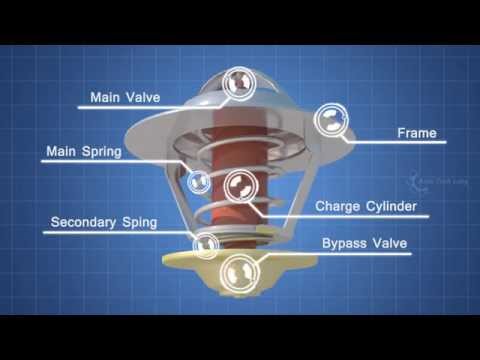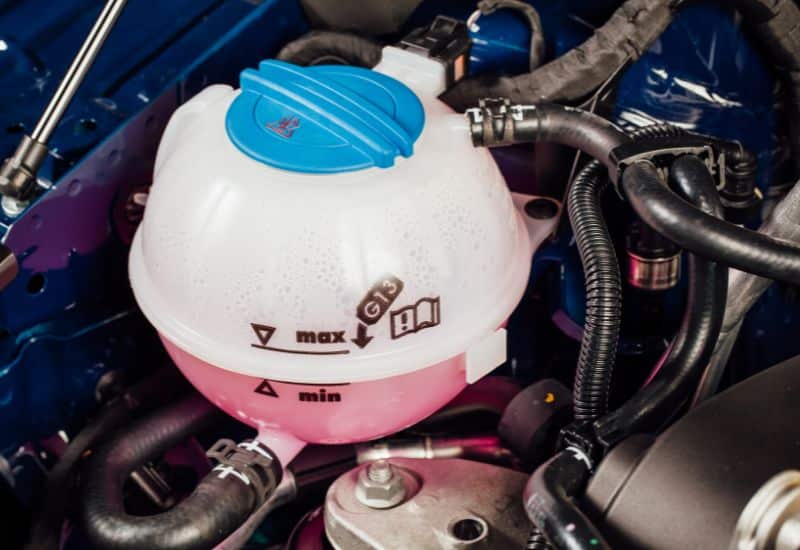
Checking your engine fluids at least once a week is a good habit to get into. Sliding the dipstick out to check the oil, giving a glance at the transmission fluid, and taking a peek at your coolant reservoir only takes a few seconds, but it can save you hundreds of dollars by catching a minor problem before it blows up into something major.
Let’s say one day you look at your coolant reservoir and see it’s low. Your heart races, worried that there might be a major leak that could leave you overheated and stranded on the side of the road. You look under the car and around the radiator for all usual suspects but still can’t find any leaks.
At this point, it seems clear that finding out why your coolant level is low, without any obvious leaks, will require some serious sleuthing.
How Does an Engine Coolant System Work?
Most modern-day cars have a liquid cooling system made up of a radiator, a water pump, a cooling fan, hoses, and a thermostat. The cooling system is driven by the water pump, which is powered by a pulley connected to the engine’s serpentine belt.
As the serpentine belt spins, the water pump continually passes liquid through the system and into carefully engineered passages in the engine block. The coolant then absorbs some of the heat energy from the engine. It then moves through hoses to the radiator, where the outside coming in through the grill cools it. As the coolant fluid cools, it travels through the radiator to repeat the cycle.
A liquid-cooled engine also has a thermostat between the engine and the radiator. It regulates what happens to the liquid based on the ambient temperature. If the coolant temperature drops below a certain degree, the thermostat bypasses and diverts it back to the engine block rather than the radiator.
This helps the engine maintain a specific level of heat for optimal operation. It comes into play most during the coldest days of winter when you need the engine to warm up quickly.
The coolant continues to circulate until it reaches a specific temperature. When it does, the thermostat opens the valve, which allows the coolant to travel through the radiator again. This keeps the engine warm while keeping it from overheating.
The entire system is pressurized and sealed to keep the coolant from boiling out of the hot engine. If the pressure from the super-heated coolant gets too high, it is diverted to the reservoir. At that point, a special gasket in the cap relieves that pressure as hot air without letting the coolant escape from the cap.
Some newer cars and high-performance models also have a water jacket around the intake manifold. This is another extension of the engine coolant system, which helps maintain the proper operating temperature for the engine block.
5 Likely Reasons for Coolant Loss Without A Visible Leaks
There are a few obvious and not-so-obvious places where your engine coolant can pull a disappearing act, leaking away without the blatantly obvious sins of a leak. If you’re lucky, it’s something minor that you can fix on your own, like a loose hose clamp. However, low coolant without any obvious leaks can also be a sign of a very serious problem like a blown head gasket.
1. A Bad Thermostat Gasket
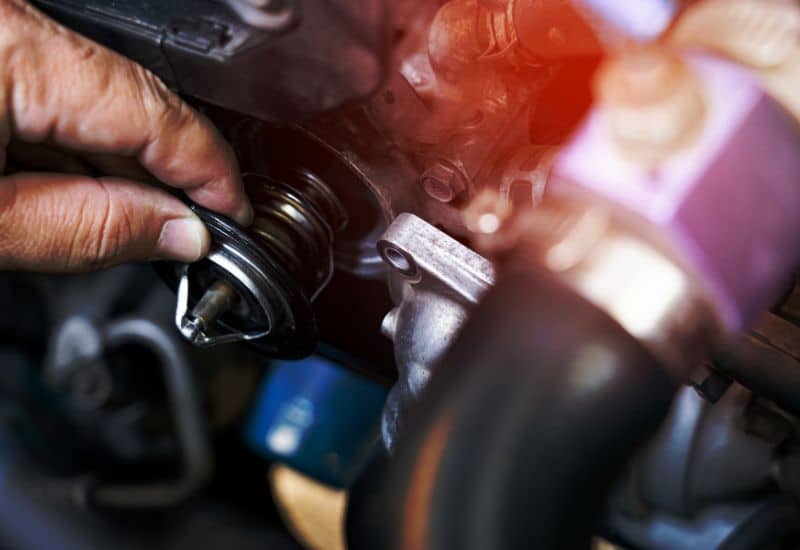
A failure in the thermostat or its seal with the radiator can create an almost imperceptible coolant leak that gradually leaves you low on radiator fluid. The thermostat usually sits on the top of the radiator and holds the pressurized seal of the system with a small gasket.
Heat and time can degrade that gasket; it’s also possible for the thermostat to get stuck open, allowing hot fluid to affect the gasket continually.
During a long drive, a tiny amount of coolant can seep out of the failing thermostat seal. The hot metal around the fluid evaporates almost instantly. When you go to look later, all you see is some white smudges or perhaps a little stray crud near the thermostat.
If you keep driving with a bad thermostat or a leaking thermostat gasket, the problem continues. Little by small amount of leaking fluid evaporates, leaving you with low coolant in the reservoir.
2. The Radiator Cap
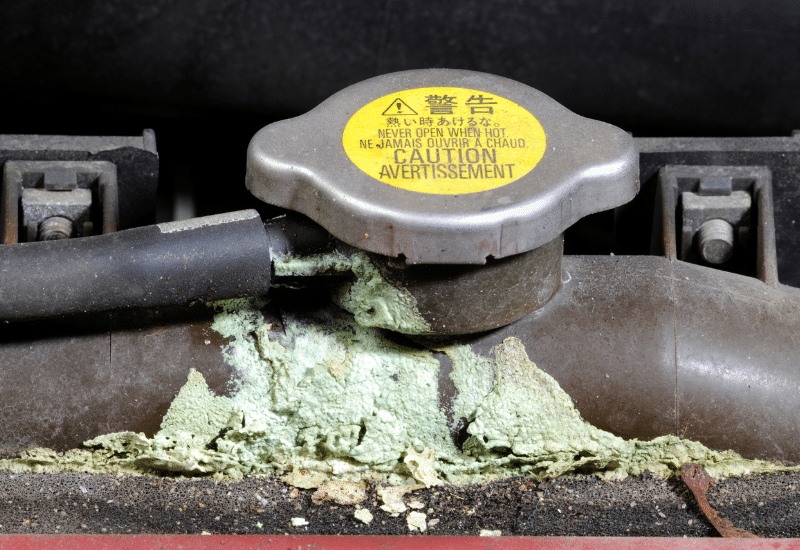
A failure in the radiator cap’s pressure relief valve can be another nearly imperceptible way for coolant to leak out of the system without any overt signs of a major lake. When the engine is cold, the gasket can remain open. As you drive, the coolant gets super-heated and starts to boil. Small amounts then spurt out of the failed radiator cap valve, leaking away.
Given enough time and inattention, this type of leak can leave you with low coolant and no evidence beyond a few tiny white smudges around the radiator cap as a clue.
3. The Head Gasket
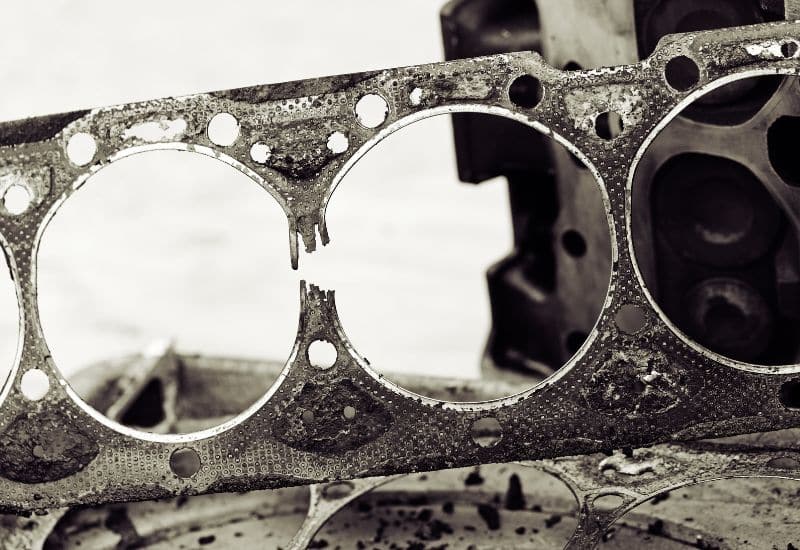
A blown head gasket can also cause an internal coolant leak with no obvious outward signs inside the engine bay. The cylinder head maintains a pressure-tight seal via a heavy-duty head gasket.
If the engine frequently runs hot or you suffer a recent overheating issue, the head gasket can fail or blow without any immediate outward signs, causing an internal coolant leak.
When this happens, the relationship between the engine oil and coolant can intermingle in the combustion chamber, causing all sorts of problems. Not the least of which is fouling your oil, letting oil into the cooling system, and affecting engine performance. It can also cause the engine to run increasingly hot.
It’s even possible for the coolant leaking into the blown head gasket to sneak into the cylinders, where it eventually escapes out of the exhaust manifold. It then passes through the catalytic converter and vanishes out the tailpipe as thick, white, sweet-smelling steam. Depending on the severity of the leak, this can leave you with a rapidly low coolant level.
4. The Intake Manifold
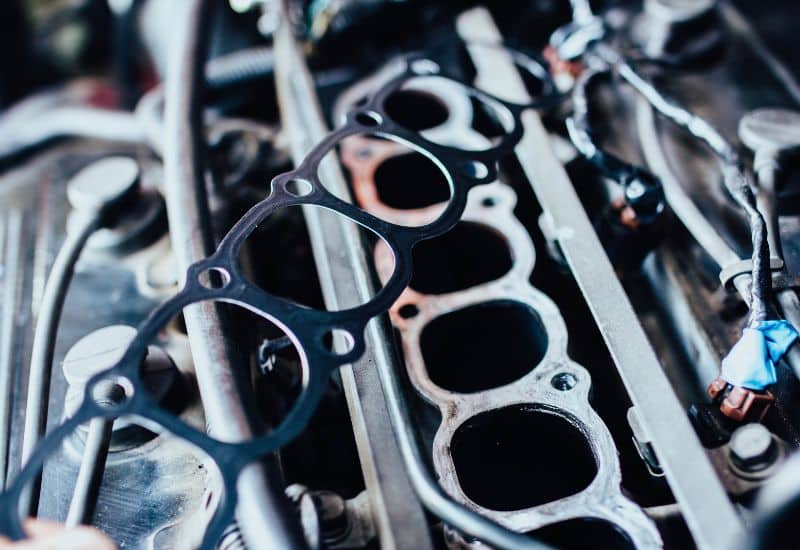
If your car has an intake manifold with a water jacket, a failure in the gasket can lead to an internal coolant leak with no obvious external signs. There’s a gasket that completes the seal, which can fail when routinely exposed to high heat. When this happens, a small amount of coolant can leak out and be drawn into the combustion chamber itself.
The problem here is that you’ll get the same white, sweet-smelling exhaust of a blown head gasket. Even though the head gasket itself might be fine. The defining characteristic between the two is that a blown intake manifold gasket with a water jacket will let more air into the system. This fuel/air mixture imbalance makes it slightly more likely to throw a check engine light.
5. The Turbocharger
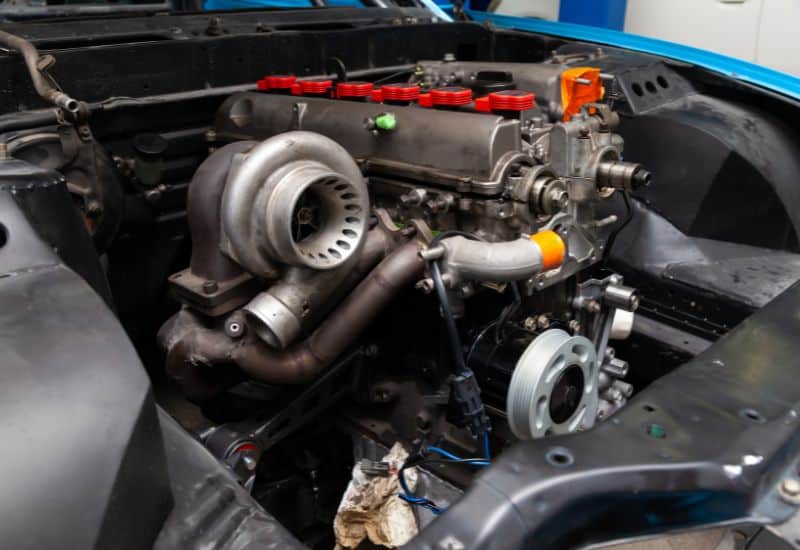
If your coolant level is low, with no obvious leak, and your car has a turbocharger, there might be a failure in the seal between the compressor and the engine. The coolant escapes the seal and finds its way into the combustion chamber, leaving you with a mysteriously low coolant level in the reservoir. This might also allow oil to enter the system.
This problem can also lead to longer-than-normal lag time while the turbo spools up. A higher-pitched whine or whirring noise usually follows this.
Troubleshooting the Cause of Low Coolant with No Visible Leaks
If you’ve got low coolant without a noticeable leak, then you will have to go into the super-sleuth mode to find where the coolant is going and what can be done about it. This is one of those times where it helps to start by looking at simple things first before diving headlong into major faults.
1. Perform a Visible Inspection with the Engine Running

You need to start the engine and let it run long enough to get warm. Once the temperature gauge in the dash cluster gets past the big letter C, the coolant should fully circulate through the system.
Pop the hood and look around for any little puffs or wisps of steam. Make sure to check the following:
Sometimes, a minor coolant leak from something as simple as a failed hose clamp can drip down onto the hot exhaust manifold. It then evaporates before the leaking coolant has a chance to make it to the ground. It’s also possible for a blown head gasket to let coolant leak onto the top of the engine block, where it simmers and evaporates.
Engine coolant has antifreeze in it that leaves behind a white film when it leaks onto a hot object, like the top of the radiator of the engine block. This film can also trap dust and pollen, making it look a little bit like it’s part of the engine’s natural patina.
Even if you don’t notice any obvious leaks or puffs of steam around the radiator cap, thermostat housing, or the top of the engine, take the time to wipe them down with a dark-colored, clean rag. You may have found your secret coolant leak if it picks up a white, sweet-smelling residue.
If your radiator cap is faulty and not relieving the pressure, your coolant reservoir might be high and/or overflowing. This is easy to overlook, so watch the reservoir levels while the engine is hot for a few seconds.
2. Check the Exhaust Coming Out of the Tailpipe
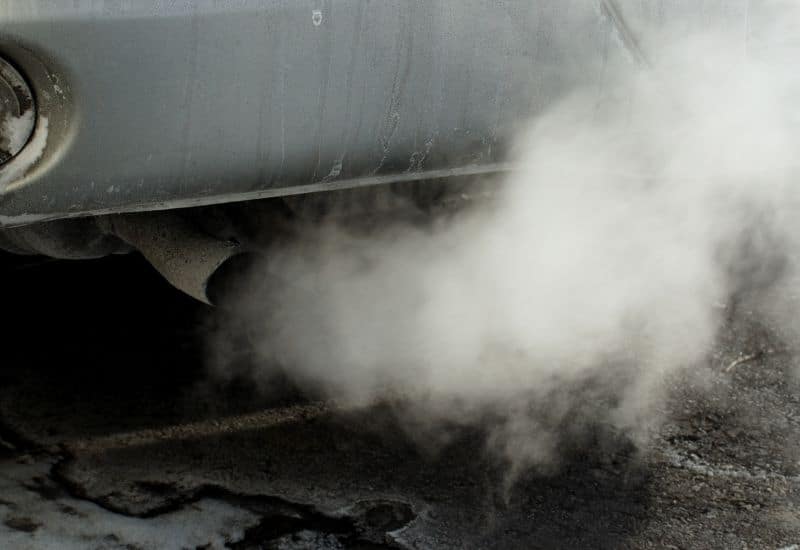
If coolant leaks into the cylinders via a blown head gasket, failing turbo seal, or the intake manifold’s failing water jacket, you’ll see it coming out the tailpipe as thick, white, opaque steam. If possible, have someone else sit in the driver’s seat, revving the engine.
If the head gasket or intake manifold gasket is the cause of the coolant leak, you’ll see the white smoke in the exhaust get noticeably thicker a few seconds after each rev.
3. Check Your Oil
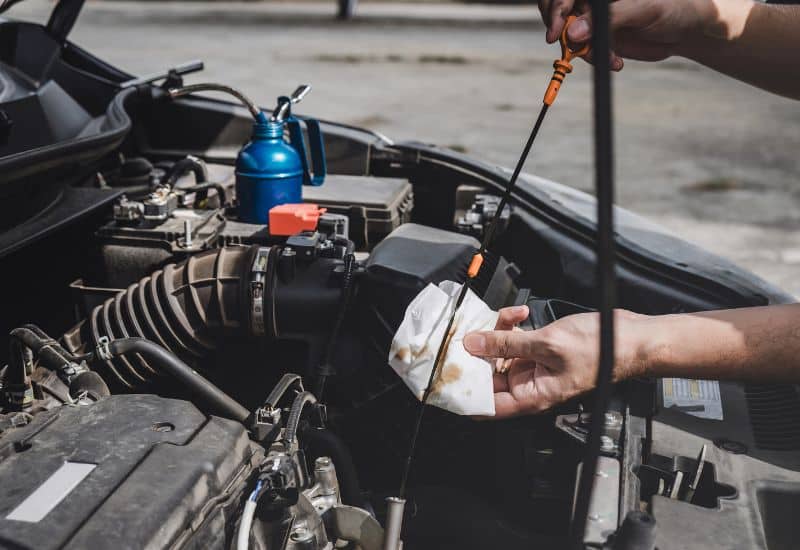
If you see white smoke coming out of the tailpipe indicative of a coolant leak allowing fluid into the combustion chamber, then it’s only a matter of time before it ferrets its way into the oil system.
This will show up as tiny bubbles, oil that looks a little bit like chocolate milk, or a dark residue on the dipstick. Your oil pressure on the dash console might be reading a little high as the fluid volume in the oil pan and the system is high.
4. Check Your Codes
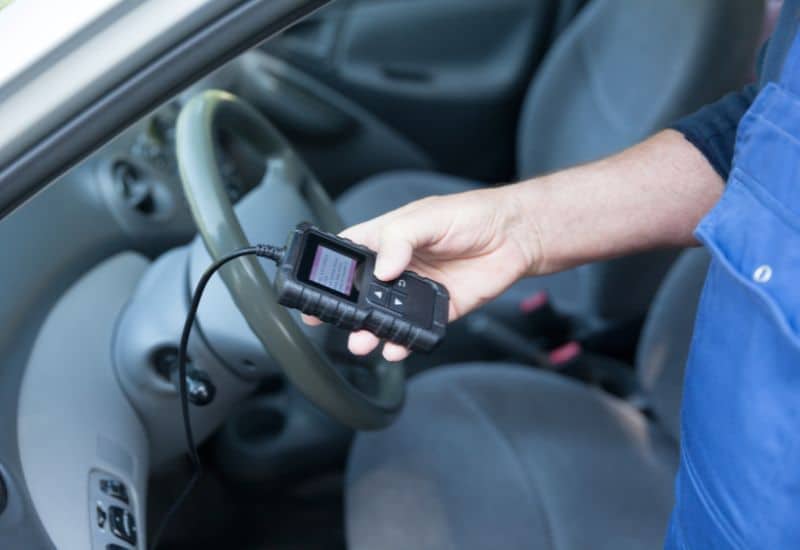
If the check engine light comes on when you have low coolant, the ECU will throw a code that an OBD II code reader can pick up. The type of malfunction the code reveals might help you find the source of the secret coolant leak.
Frequently Asked Questions
How Do I Confirm My Coolant Level Is Low?
The best way to confirm that your coolant level is indeed low is to let the car sit for at least an hour or two to let the engine and all the fluids cool down. This will let them return to their correct level. If the system is hot, the level in the reservoir can be higher or possibly lower than it is within the engine cooling system.
Once you’re convinced the engine and cooling system are back to ambient temperature, pop the hood and look at the coolant reservoir. The coolant level in the semi-transparent case should be between the High and Low lines. If it’s at, near, or below the Low-level line, then you do indeed have low coolant and a possible coolant leak.
Can a Stuck-Closed Thermostat Cause a Coolant Leak?
If your thermostat fails and it’s stuck closed, the increasing temperature can cause the gasket seal to fail completely. This will cause coolant to leak out, where it can evaporate, leaving you with a low coolant level.
If you’re sitting idling at stop lights, you’ll notice the wisps of steam and the rapidly rising temperature reading on the dash console. Not to mention, the engine will be dangerously close to overheating. If you’re driving fast and/or it’s a cold, windy day, you might not notice the steam or the temperature change.
Why Do I Smell Sweet Coolant Coming Out of My Vents?
A coolant smell coming out of your vents when you have the heater on and the fan set to medium-high is usually either a leak in the heater core or a stuck-open thermostat. These are minor coolant leaks that will only show a major change in the coolant level if you let them go for a long period of time.
Conclusion
If your coolant is low, but you don’t see any obvious leaks or puddles under the car, you could be dealing with something minor, like a bad radiator cap, or something much more serious, like a blown head gasket. Regardless, it’s time to put on your detective cap because the longer you put off finding the source, the more expensive the fix will likely be.
When troubleshooting, make sure to let the car heat up to the point that the thermostat opens and coolant is allowed to flow through the system. Pop the hood and look for signs of steam around the thermostat housing, radiator cap, top of the engine, and down by the exhaust manifold. Then, walk to the back of the car and have someone else rev the engine.
If you see thick, white smoke coming out of the tailpipe, you know that coolant is getting into the cylinders via a blown head gasket, failed seal on the intake manifold’s water jacket, or the turbocharger. If the check engine light flashes or comes on, you can use the codes to help dial in the true source of the mysterious coolant leak.

Written By
Jason Farrell
Jason Farrell is a certified master technician, the editor of Mechanic’s Diary in Pittsburgh, Pennsylvania. He is ASE (Automotive Service Excellence) certified and earned a Bachelor’s Degree in Automotive Technology from Pittsburg State University. With nearly 18 prior years of experience in the automotive field, he has extensive knowledge about Domestic, European, and other foreign makes and models of cars and light trucks. Jason’s experience working as a technician and service manager at dealerships, gave him the experience and know-how of most aspects of inspection, diagnosis, and repair from engine and drivability to electrical, HVAC, brakes, steering and suspension and everything in between.

